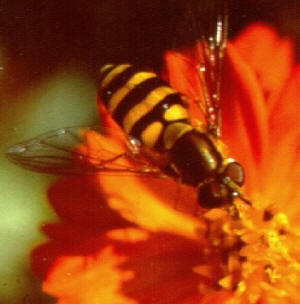|
Column
Sweat Bees and Syrphid Flies, Rust on
Hollyhocks, and That sticky mess under trees
By John Fulton
 Send a link to a friend
Send a link to a friend
[July 29, 2014]
Sweat Bees and Syrphid Flies -
Everyone seems to be having troubles with “sweat bees” these days.
Or are they sweat bees? Sweat bees are about a quarter of an inch
long, and are usually a metallic green in color.
|
|
 The yellow and black insects commonly called sweat bees are
actually flies. Syrphid flies to be correct. When in doubt,
count the wings (I know – easier said than done). Bees will have
two wings per side, while flies have one. The yellow and black insects commonly called sweat bees are
actually flies. Syrphid flies to be correct. When in doubt,
count the wings (I know – easier said than done). Bees will have
two wings per side, while flies have one.
Syrphid fly is a generic name given to an entire group of flies.
There are some differences in appearance and color, but the
yellow and black color is the major one in our area. The other
names for syrphid flies are hover flies or flower flies. They
tend to hover around your arms and face when you have been
perspiring, and land to lap up the sweat. They are also commonly
found on flowers, hence the flower fly name, and do a good job
of pollinating.
 Syrphid
flies are actually beneficial insects. They help pollinate,
larvae feed on dead organic matter, and the larvae are predators
of aphids. They cannot sting, but their mouthparts can usually
be felt when lapping up sweat from sensitive areas. You may feel
a slight pinch which makes you feel like you’ve been stung or
bitten. Syrphid
flies are actually beneficial insects. They help pollinate,
larvae feed on dead organic matter, and the larvae are predators
of aphids. They cannot sting, but their mouthparts can usually
be felt when lapping up sweat from sensitive areas. You may feel
a slight pinch which makes you feel like you’ve been stung or
bitten.

Rust on Hollyhocks
 Hollyhocks
are one of the traditional, old-fashioned flowers often grown in
our area. This year, they are definitely interesting – that is
if yours survived the winter. Most area hollyhocks are infected
with rust. Rust is usually a spring and fall disease problem,
when it occurs. This year it has kept going with the type of
weather we have experienced. Hollyhocks
are one of the traditional, old-fashioned flowers often grown in
our area. This year, they are definitely interesting – that is
if yours survived the winter. Most area hollyhocks are infected
with rust. Rust is usually a spring and fall disease problem,
when it occurs. This year it has kept going with the type of
weather we have experienced.
Rust first shows up on the bottom of the lower leaves, and the
top side of the leaves has some rather striking bright yellow to
orange spots develop. Rust can attack all plant parts including
leaves, stems, and leaf petioles. The rust disease spends the
winter in old plant parts on the ground. Removal of the plant
material will help reduce infection possibilities. Increasing
air flow and reducing humidity will also help. Control is best
accomplished by removing infected leaves at the first sign of
the rust (on the bottom of the leaves). Chemical control may
needed, and sprays containing sulfur are effective.
[to top of second column] |

That sticky mess under trees
People are once again complaining about leaking sap coming from
trees. What happens is a fine mist of sap coats things beneath a
tree. This is actually called “honeydew,” which is a secretion
of sucking insects such as aphids and lacebugs. What makes
matters worse is a fungus begins growing in the honeydew, making
it turn black.
There are two ways to deal with the problem. The first way is to
spray the entire tree with a product, such as malathion, to kill
the insects. The second way is to move anything portable from
under the tree. If you opt for the first option, you need to
make sure you can spray the entire tree. The presence of the
syrphid flies this early indicates there is a food source
available – such as the aphids causing the honeydew secretions.
[By JOHN FULTON, COUNTY EXTENSION
DIRECTOR SERVING LOGAN, MENARD, AND SANGAMON COUNTIES]

 |